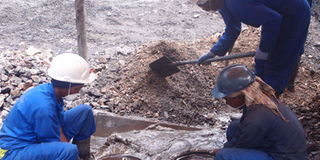Lessons from Rwanda’s mining sector

Women participate in wolfram mining at Nyakabingo mine. Rwanda aims to increase this figure to 60,000 by 2017/2018 with at least 30 per cent of the workers being female and youth. PHOTO by Abdulaziizi K. Tumusiime
What you need to know:
Closing operations. A number of mining companies in Uganda have ceased operations because of the delay to put in place the certification mechanism
While the Rwandan government has over the last five years made several progressive steps to maximise its young mining industry potential, Uganda still has a long way to go.
The country is host to a number of minerals but the predominantly mined and traded ones are; cassiterite, wolframite, colombo-tantalite and gold. Extraction of gemstones such as sapphire, beryl and tourmaline has increased over the years.
Today, mining in Rwanda is considered the second foreign export earner after tourism. Export earnings from the sector rose from Shs110 billion ($40 million) in 2006 to Shs626 billion ($226 million) in 2013. And, the land of a thousand hills is not resting on its laurels. By 2017/2018, it aims to almost double the export earnings to $400 million.
More than 600 licenced mining companies and co-operatives carry out prospection, exploration at beyond 648 sites across Rwanda. These employ about 34,000 Rwandans. The government is aiming to increase this figure to 60,000 by 2017/2018 with at least 30 per cent of the workers being female and youth.
Rwanda’s gains in mining
The rosy figures from the sector “did not fall from the sky.” They are a result of carefully drawn and strictly implemented policies. The journey to the fresh feats in the sector can be traced to 2007 when it was privatised.
“Productivity, henceforth, increased,” says Mr Evode Imena, the Minister of State in charge of mining.
In Rwanda, artisanal miners who contribute more than 70 per cent of total mineral production have been embraced and helped in enhancing their productivity. But in Uganda, artisanal miners have often complained about being marginalised with preference given to large-scale operational mining companies.
“One of the things we do to better the artisanal miners’ capacity is organise field trips where they visit the large scale companies and learn the latter’s workings. Supporting the artisanal miners encourages transparency in their operations,” explains Mr Imena.
This move is in line with one of the tools of the 2010 International Conference on the Great Lakes Region (ICGLR) Lusaka Declaration which calls for the formalisation of artisanal mining.
In 2010, member states of the Great Lakes region sat in Kampala and came up with six measures to reduce illegal exploitation of natural resources. Rwanda was the first country to implement the regional certification mechanism (the most important tool of the six) — tracking the chain of supply of minerals to their mines. Adopting this tool has increased the credibility of minerals from Rwanda, on the international market.
“It is easier for us to export our minerals,” says Mr Peet Miller the mine manager at Nyakabingo Mine.
Uganda’s case
Uganda is yet to implement the traceability scheme which is related with section 1502 of the Dodd – Frank Act, a US legislation which seeks to stop companies from buying “conflict minerals” from DR Congo and its nine adjoining neighbours (Tanzania, Zambia, Central African Republic, Angola, Uganda, Rwanda, South Sudan and Burundi) sold to benefit illegally armed groups. It is reported that a number of mining companies in Uganda have ceased operations because of the delay to put in place the certification mechanism.
However, the country’s mining industry, like any other, faces a couple of challenges. Top on the pack is access to finance from banks to fund the usually expensive mining operations.
“We also face the challenge of shortage of experienced and skilled personnel in the sector. The others relate to environment protection and occupational health and safety,” says the minister in charge of mining.
The future
Value addition is the dream for Rwanda, according to Mr Mahmoud Salem, the President of Rwanda Mining Investment Forum. Mr Salem argues promoting value addition will uniquely position Rwanda in the region and propel its economy.
“Everyone will come from neighbouring countries to sell their minerals because the country has an instant market,” explains Mr Salem.
In the spirit of achieving the dream of value addition, Mr Imena says the country is reviving a plant where casserite is transformed into tin.
“It will be the first conflict free certified plant in the great lakes region.”
The bright side is that Rwanda and Uganda’s future aspirations, in regard to value addition, are the same. During this year’s mineral wealth conference, President Museveni urged investors in the mining industry to prioritise value addition in order to boost the country’s economy.
The onus is now on Uganda to emulate Rwanda’s will power and discipline in order to achieve the goal sooner.
The Numbers
Shs30 trillion
Worth of Uganda’s gold deposits
Shs44 trillion
Worth of Uganda’s iron ore deposits




